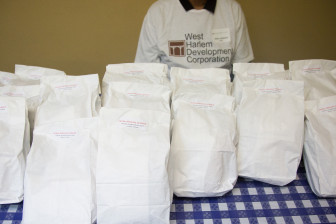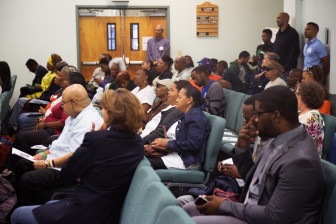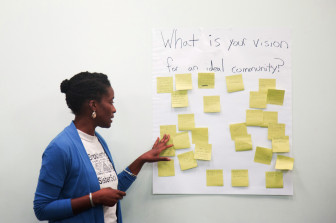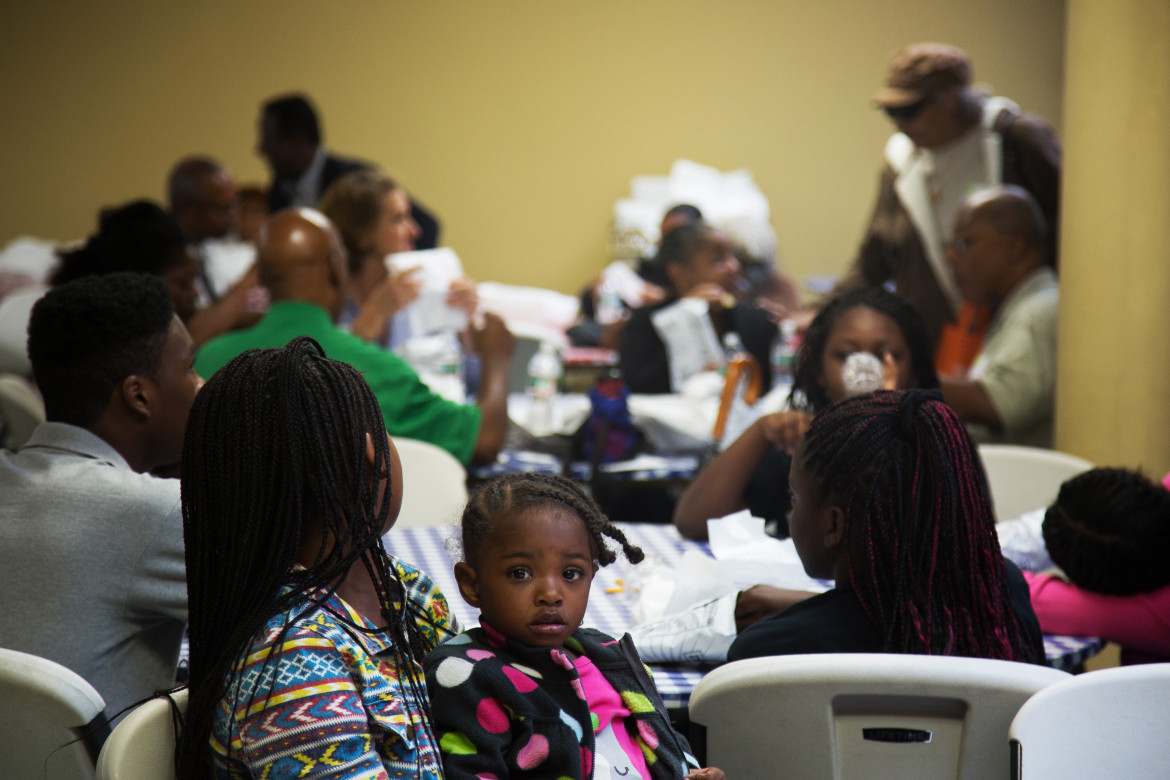
Jackie Snow
The West Harlem Development Corporation held a meeting at Manhattan Pentecostal Church for residents of the Grant and Manhattanville houses to air their grievances after a mass raid by the NYPD in June.
NEW YORK — Last summer, when the feud between the youth from the rival Manhattanville and Grant Houses in West Harlem was at its chaotic and bloody peak, Derrick Haynes and Taylonn Murphy had an idea. Close down Old Broadway, the short street both sides considered a neutral zone, for the day and bring in some portable basketball courts, some games and other athletic equipment. Once the youth came out, they would lure them to a job training program hosted in the cramped Community Board 9 headquarters on the same street. At the very least it would be an opportunity for the two sides to come together, even if it was just for a few hours, to a safe place.

Jackie Snow
The West Harlem Development Corporation provided lunch for attendees from the Grant and Manhattanville houses, as they met to air their grievances after a mass raid by the NYPD in June.
Despite a week of shootings, beatings and calls for vengeance, about two dozen young people came out on that sweltering summer afternoon. The brother of slain basketball star Tayshana “Chicken” Murphy and the brother of her convicted killer Tyshawn Brockington exchanged heated words, but the meeting ended with no violence and a handful of young men took the first steps to enrolling in a job training program and taking the first steps to connecting with the construction union.
Murphy and Haynes, who have both lost family to the bloody feud between the housing projects that led to the biggest raid in the history of the New York City Police Department, credited their success that day to the trust they had built with the young people on both sides of Old Broadway.
It was something that was decidedly missing, they and other residents said, at a Saturday meeting organized by the West Harlem Development Corporation. Supposed to be an opportunity to reach out to the youth for ideas on what to do to stem the violence, it instead turned into a bull session for the middle-aged and elderly.
A moderator asked the crowd of more than 100 if they were 24 or younger. Two people, a girl and a young woman, tentatively raised their hand.

Jackie Snow
Critics of the meeting said youth were under-represented: out of a crowd of more than 100, only two raised their hands when asked who in attendance were 24 or younger.
A woman from the West Harlem Development Corporation (WHDC), the nonprofit arm of Columbia University that hosted the event, whispered into the moderator’s ear. She asked how many people were 30 or younger. Another three attendees in the pews of the Manhattan Pentecostal Church, which hosted the meeting, raised their hands. That brought the total to five youths, loosely defined.
Critics said this was a sign of the disconnect between the youth, some of whom are returning home from jail as their cases await trial, and the formal institutions like the WHDC that say they want to help these young people but don’t know how to reach them.
The WHDC controls a massive grant as part of a community benefits agreement with West Harlem for Columbia University's Manhattanville campus expansion. During negotiations, it was determined that $3 million of the fund would be designated for the residents of Manhattanville and Grant houses. Organizers had hoped residents and youth would come out to offer their input on how to most effectively apply those funds.
Organizers had touted Saturday’s meeting as an opportunity to jump-start a dialogue with the residents from the Manhattanville and Grant houses in the wake of the NYPD’s military-like historic raid on June 4.
“Today is a day for the residents of Grant and Manhattanville to tell the West Harlem Development Corporation what you need,” said WHDC Executive Director Kofi Boateng from the church’s pulpit.
The meeting kicked off with a song-and-dance routine by young people from Impact Repertory Theatre, a troupe of youths that received grant money from the WHDC, among others. They performed two numbers from a hip-hop musical called “Peace Warriors,” inspired by the warring youths.
 At one point, Boateng asked Murphy and Arnita Brockington to come up to the stage. He recounted the two parents’ story: how Murphy’s daughter was gunned down, and after Brockington’s son was convicted the two made a pact to end the violence so other parents wouldn’t lose their children to a grave or a prison cage. Some attendees gasped as they listened. Neither Murphy nor Brockington spoke.
At one point, Boateng asked Murphy and Arnita Brockington to come up to the stage. He recounted the two parents’ story: how Murphy’s daughter was gunned down, and after Brockington’s son was convicted the two made a pact to end the violence so other parents wouldn’t lose their children to a grave or a prison cage. Some attendees gasped as they listened. Neither Murphy nor Brockington spoke.
Brockington said later she wasn’t surprised people had never heard her story before, even though Tayshana “Chicken” Murphy’s death is well-known in West Harlem.
“That was the first time they ever invited us up,” she said. “That’s the first time they ever even acknowledged us.”
Murphy and Brockington both said they were frustrated at how the WHDC sentimentalized their experience for the crowd, but did not talk about the tangible anti-violence steps they are taking: going into the courtyards and streets to intervene in burgeoning conflicts before they turn dangerous.
The audience split into three working groups that discussed funding and programs. The meeting ended with no suggestions for further discussion proposed. Another, similar meeting is set for Sept. 23.
Other organizers, like Boateng, said Saturday’s meeting was the beginning of an “important conversation” on how to stem the violence that has defined the two houses in recent years.
However, Murphy and Haynes said they have been having this conversation for three years.

Jackie Snow
A meeting bringing together Grant and Manhattanville houses was held at Manhattan Pentecostal Church to let residents talk about the future of their community after a mass raid by the NYPD in June left many angry.
They had hoped the WHDC would revisit their proposal of a full-time play street and a 24-hour intervention center staffed by counselors with real-life experience that youth in the projects could identify with, especially in moments of crisis.
“Tell me this,” Haynes asked. “Who else is asking to be put in the middle of a war? Who else is begging to be thrown in the middle of this fight? We are the only people foolish enough to do this, but we are confident with our credibility in the community our plan will change the culture out here.”
Murphy agreed, saying he hoped WHDC would reconsider supporting the work they have done intervening, counseling and mentoring the youth.
“We’ve been running around these streets for the last three years,” he said. “Why can’t they just put our plan in place?”
Murphy said he thinks the intentions are good, but that the only people who can fix the problem in the houses are people who have lived it.
“The people who are affected by this issue are not being put into a position to deal with this issue and that’s why there’s no passion behind this,” he said. “This is just a job for them. And when it’s just a job it goes from to 9 to 5. But for me it’s my life; it’s intertwined in my life and Derrick’s life every day.”
Boateng said he thought the fact that there were no fights or skirmishes during the meeting supported his contention that no rivalry exists between the two houses. “It’s a myth,” he said. “This idea that they have this feud is not true; we saw that today.”
He did not think the lack of youth at a youth meeting was a problem, he said. He expects the elders who attended to report back to the youth and that that news will embolden them to come to the next meeting.
Councilman Mark Levine, who represents the district where residents of both houses live, said he hoped the shared dedication to fixing the problems would lead to long-term solutions.
“We’re all here for one simple reason: We don’t ever want to lose one of our precious young people to violence — not a son, not a daughter, not a grandchild, not a neighbor,” he said. “To get to that situation it’s not enough to say, ‘That’s for the police to deal with.’ All of us have to do more to create a better life for the young people of this community.”
He, too, said he was worried about the lack of youth at the meeting.
“Hindsight is always 20/20,” he said after the presentation. “But one thing we should’ve considered was an event that was only for young people so they wouldn’t be scared off by a bunch of annoying adults. But you know it’s tough, very tough, to get young people to come out. It presents a real challenge.”
Donald Notice, a longtime housing activist and community organizer in Harlem, recognized the need to have more effective outreach to the population that is suffering the most.
“We have to start engaging our youth and getting them into these innovative programs,” he said. “We need to figure out how to get the youth in the room and start talking to them.”
Nikole Gellineau, who lives in Manhattanville, has two children embroiled in the raid investigation. She consulted with her younger son, Naquan, who is out on bail for gang charges related to the raid. She sat in on the working group for youth since they could muster only five participants. She was one of the only mothers from either housing project who came to the meeting.
She told the story of how one son went to play basketball at the recently reopened community center and gym and was turned away without explanation. She said it’s indicative of the gap between how larger organizations diagnose the problem and how people who are living the life view it.
“It’s not even about them listening to the truth at this point,” said a frustrated Gellineau after the meeting. “They don’t know it. They have no idea. They have no idea the lives we’re living over there,” she said pointing toward the houses. “Unless you have walked the walk, you have no idea.”
Brockington, like Murphy and Haynes, said she appreciated the generous spirit behind the meeting, but sees a sort of wonkish monotony to the same soaring rhetorical calls for change, with none of what she described as the street sense to back it up.
“I think all these meetings are the same,” she said. “They still need adults with moral authority, people the youth can trust, from inside the community to deal with the children.”
The last time she visited her younger son Naquan, 18, at the time still on Rikers Island, they talked about what could be done to fix what many see as an intractable problem of youth violence.
“I wish I would’ve listened to you, Ma, you and Mr. Murphy,” she recounted.
If he ever gets a chance to get out of legal trouble, he never wants to return to either of the houses, Naquan said.


Pingback: Few Harlem Youths at Planning Meeting Against Violence